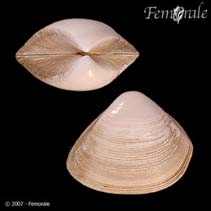Spisula subtruncata (da Costa, 1778)
Subtruncate surf clam
Classification / Names Common names | Synonyms | CoL | ITIS | WoRMS
| Venerida | Mactridae
Environment: milieu / climate zone / depth range / distribution range Écologie
; saumâtre; profondeur 0 - 25 m (Ref. 2758). Subtropical; 71°N - 30°N, 10°W - 36°E
Distribution Pays | Zones FAO | Écosystèmes | Occurrences | Introductions
Eastern Atlantic and the Mediterranean.
Length at first maturity / Taille / Poids / Âge
Maturity: Lm ? range ? - ? cm Max length : 3.0 cm SHL mâle / non sexé; (Ref. 7882)
Depth based on occurrence (Ref. 2758, p. 805); to be replaced with better reference. Species' maximum length from the Belgian part of the North Sea (Ref. 7882). Found in subtidal environment in coastal areas of Europe (Ref. 80598). Lives in shallow soft bottoms (Ref. 80581); in varied sediment types: from fine to coarse sand and mud (Ref. 7882). An active suspension feeder (Ref. 96376).
Life cycle and mating behavior Maturité | Reproduction | Frai | Œufs | Fécondité | Larves
Members of the class Bivalvia are mostly gonochoric, some are protandric hermaphrodites. Life cycle: Embryos develop into free-swimming trocophore larvae, succeeded by the bivalve veliger, resembling a miniature clam.
Référence principale
Références | Coordinateur | Collaborateurs
Gaspar, M.B., M.N. Santos and P. Vasconcelos. 2001. (Ref. 2758)
Statut dans la liste rouge de l'IUCN (Ref. 130435)
statut CITES (Ref. 108899)
Not Evaluated
CMS (Ref. 116361)
Not Evaluated
Menace pour l'homme
Utilisations par l'homme
| FishSource |
Outils
Plus d'informations
Pays
Zones FAO
Écosystèmes
Occurrences
Introductions
Stocks
Écologie
Régime alimentaire
Éléments du régime alimentaire
Zones FAO
Écosystèmes
Occurrences
Introductions
Stocks
Écologie
Régime alimentaire
Éléments du régime alimentaire
Sources Internet
BHL | BOLD Systems | CISTI | DiscoverLife | FAO(Publication : search) | Fishipedia | GenBank (genome, nucleotide) | GloBI | Gomexsi | Google Books | Google Scholar | Google | PubMed | Arbre de Vie | Wikipedia (Go, chercher) | Zoological Record



